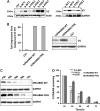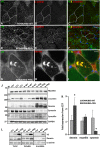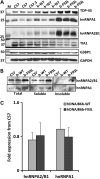Myofibrillar disruption and RNA-binding protein aggregation in a mouse model of limb-girdle muscular dystrophy 1D
- PMID: 26362252
- PMCID: PMC4634370
- DOI: 10.1093/hmg/ddv363
Myofibrillar disruption and RNA-binding protein aggregation in a mouse model of limb-girdle muscular dystrophy 1D
Abstract
Limb-girdle muscular dystrophy type 1D (LGMD1D) is caused by dominantly inherited missense mutations in DNAJB6, an Hsp40 co-chaperone. LGMD1D muscle has rimmed vacuoles and inclusion bodies containing DNAJB6, Z-disc proteins and TDP-43. DNAJB6 is expressed as two isoforms; DNAJB6a and DNAJB6b. Both isoforms contain LGMD1D mutant residues and are expressed in human muscle. To identify which mutant isoform confers disease pathogenesis and generate a mouse model of LGMD1D, we evaluated DNAJB6 expression and localization in skeletal muscle as well as generating DNAJB6 isoform specific expressing transgenic mice. DNAJB6a localized to myonuclei while DNAJB6b was sarcoplasmic. LGMD1D mutations in DNAJB6a or DNAJB6b did not alter this localization in mouse muscle. Transgenic mice expressing the LGMD1D mutant, F93L, in DNAJB6b under a muscle-specific promoter became weak, had early lethality and developed muscle pathology consistent with myopathy after 2 months; whereas mice expressing the same F93L mutation in DNAJB6a or overexpressing DNAJB6a or DNAJB6b wild-type transgenes remained unaffected after 1 year. DNAJB6b localized to the Z-disc and DNAJB6b-F93L expressing mouse muscle had myofibrillar disorganization and desmin inclusions. Consistent with DNAJB6 dysfunction, keratin 8/18, a DNAJB6 client also accumulated in DNAJB6b-F93L expressing mouse muscle. The RNA-binding proteins hnRNPA1 and hnRNPA2/B1 accumulated and co-localized with DNAJB6 at sarcoplasmic stress granules suggesting that these proteins maybe novel DNAJB6b clients. Similarly, hnRNPA1 and hnRNPA2/B1 formed sarcoplasmic aggregates in patients with LGMD1D. Our data support that LGMD1D mutations in DNAJB6 disrupt its sarcoplasmic function suggesting a role for DNAJB6b in Z-disc organization and stress granule kinetics.
© The Author 2015. Published by Oxford University Press. All rights reserved. For Permissions, please email: journals.permissions@oup.com.
Figures











References
-
- Palmio J., Jonson P.H., Evila A., Auranen M., Straub V., Bushby K., Sarkozy A., Kiuru-Enari S., Sandell S., Pihko H. et al. (2015) Novel mutations in DNAJB6 gene cause a very severe early-onset limb-girdle muscular dystrophy 1D disease. Neuromuscul. Disord., http://dx.doi.org/doi:10.1016/j.nmd.2015.07.014. - PubMed
Publication types
MeSH terms
Substances
Supplementary concepts
Grants and funding
LinkOut - more resources
Full Text Sources
Other Literature Sources
Molecular Biology Databases
Research Materials
Miscellaneous

